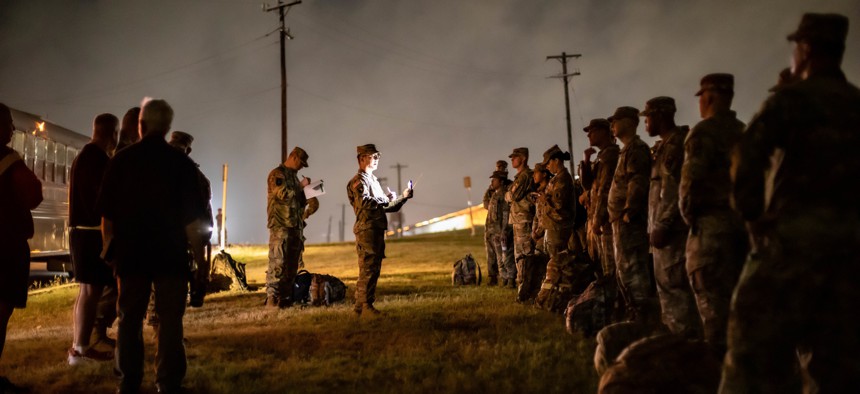
Soldiers stand in formation for accountability during an exercise on Fort Sam Houston, Texas, May 11, 2022. Spc. Joshua Taeckens
US Army Outlines Plan to Overcome ‘Most Challenging’ Recruiting Era Since 1973
The service has already shrunk below the reduced end-strength goal it set with its 2023 budget request.
The U.S. Army is relaxing more policies and reintroducing old incentives as part of its continued efforts to increase recruiting in what the Army secretary and Army chief of staff described as the “most challenging recruiting environment since the All-Volunteer Force was established in 1973” in a memo released Wednesday.
Just months ago, Army officials filed a 2023 budget request that proposed to shrink the service by 12,000 troops to 473,000. Now they foresee the force declining to 466,000 soldiers by year’s end.
“The Army has already taken steps to begin improving our recruiting efforts, and we will continue to do so, but we currently project that our end strength may further decrease to approximately 445K-452K by the end of FY23,” the memo reads.
Those steps include extending the tours of 420 of the Army's best recruiters, increasing enlistment and quick-ship bonuses, expanding Station of Choice options, and establishing a prep course that will help potential recruits boost their physical and academic capabilities to meet service standards.
The memo also outlines long-term initiatives that include upping rewards for recruiting more soldiers, applying digital technology to recruiting operations, and launching another brand refresh.
The Army’s recruiting woes are not new, and service leaders have cited “pandemic-driven constraints, intense competition with the private sector, and a declining number of young Americans interested in uniformed service.” Pandemic-era virtual schooling meant that recruiters could not visit high schools and interact with students. Wormuth and McConville also argue that the virtual format resulted in a 9 percent decrease in overall Armed Services Vocational Aptitude Battery, or ASVAB, scores.
Additionally, the Army conducted “market research” that identified three “broad gaps” between the service and its recruiting pool: a knowledge gap, an identity gap, and a trust gap. Today’s military-service-aged Americans don’t know enough about the Army, can’t see themselves in the Army, and largely don’t trust government institutions such as the military, the memo said.
In March, when the Army sent its budget request to Congress, Chief of Staff Gen. James McConville said his service was in a “war for talent.”
“We want a high-quality Army. To me, quality is more important than quantity,” McConville said. “We have to do a lot of work to expose the Army to people that really haven’t seen it before.”
The money that would have funded the additional troops—some $890 million to $1.2 billion—must now be applied to other “urgent priorities,” including reenlistment and retention bonuses. Some $550 million to $600 million are expected to go to expanded bonuses alone.
Earlier this month, the Army briefly signaled that they would waive the minimum education requirement for “a limited number” of recruits before reinstating the need for a high school diploma or GED.




